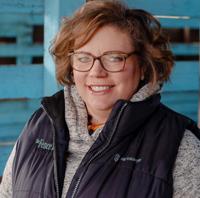GABEL | Sugar beet biz has been sweet to our state

Rachel Gabel

Rachel Gabel
It is sugar beet harvest season in Colorado and if the more scenic portions of the state are known for the Rocky Mountains, this portion of the state ought to be known for the mountains of corn silage and beets taking shape at beet dumps, factories, dairies and feedyards.
In 1898, the College Farm in Fort Collins and the substation in Rocky Ford, both part of then-Colorado A&M, conducted the most extensive experiments on sugar beet production ever. W.W. Cooke wrote in the 1898 bulletin, “the results of the season of 1898 are so conclusive, that we may feel justified in saying that Colorado can raise as good sugar beets and as large crops of beets as any place in the world.” With that matter settled, he said, future experimental work could turn to the “minor points of methods of irrigation, times and distances of planting, etc.” The experiments Cooke, a technical writer at the college’s experiment stations, referenced were distinct because they were done in cooperation with the Denver Chamber of Commerce and county commissioners around the state, who offered prizes. Even with the added incentive, he said the prizes were not as valuable as a good harvest of sugar beets delivered to the factory.
Shortly after this bulletin was published, Charles Boettcher, the namesake of the Boettcher Foundation, and his wife, Fannie, were vacationing in Europe. Boettcher had come to the U.S. from Germany at only 17 and initially made his fortune selling hardware and mining equipment. He later made money manufacturing blasting powder needed for the construction of mountain roads and tunnels. And he also was successful with an electric company and the Ideal Cement Company. He noted the bountiful sugar beet fields and harvest in Europe before he brought sugar beet seeds back to Colorado in his luggage. These seeds became the tiny start of his company, Great Western Sugar.
Great Western Sugar once had processing facilities across the northern Front Range and eastward. Beet farms employed immigrant labor, bringing financial success to local economies where the farms were located. The factories were located in Berthoud, Brush, Fort Collins, Greeley, Longmont, Loveland, Grand Junction, Eaton, Windsor and Brighton. Facilities expanded into Nebraska, Wyoming, and Montana. In 1901, the Great Western Railway was organized to serve the sugar beet industry by transporting beets, sugar, molasses, coal and lime rock. The Fort Morgan and Billings, Montana facilities were two of the largest with original factory capacities of 600 and 712 tons-per-day, respectively. Later, the Scottsbluff, Nebraska facility boasted an original factory capacity of more than 1,000 tons-per-day.
Financial hardships in the 1970s were anything but sweet and prompted the sale of Great Western to businessman Billy White, who sold controlling interest in 1974 to the Hunt Brothers organization. It changed hands once again until finally a cooperative of growers purchased Western Sugar in 2002.
Under grower ownership, Western Sugar Cooperative plants more than 134,000 acres of sugar beets and produces more than 10 million cwts (hundredweight) of local sugar annually. Sugar beets remain economically important in places like Fort Morgan, where the sole remaining sugar factory in the state is located. The coop also maintains storage facilities in Rocky Ford, Sterling and Longmont here in Colorado as well as, in Nebraska, in Bayard, Gering, and Mitchell.
Fort Morgan’s plant was built in 1906 and it is the town sugar built. The first crop processed at the factory in 1906 was reported to gross more than $1 million. Promises of yields worth $700 to $1,000 per-acre brought growth to the town and with it came Volga German immigrants. Today, many farming families with last names like Vondy, Wacker, Frihauf and Weingardt can trace their family histories back to those immigrants.
The sugar business flourished in the 1920s and the sugar companies began hiring Latino workers, often called “betabeleros.” The company provided low-interest rate loans and the Latino community grew and established a strong community that remains important and vibrant today.
When World War II took so many able-bodied men from the farms, fields, and factories in farm country, prisoners of war from Germany and Italy were utilized to bring in the beet crop. In southeastern Colorado, Japanese Americans interned at Amache, many of whom were agriculture producers from California, were instrumental in not only the sugar beet harvest, but the introduction of new farming methods to the area.
Today, in addition to sugar, the sugar beet industry plays a vital role in the state’s cattle-feeding industry. Beet pulp, a byproduct of sugar production, is an excellent ration ingredient and widely used in northern Colorado where it is plentiful. Though the sugar beet industry isn’t the sole economic giant it once was, the ag industry and state’s economy is sweeter for it.
Rachel Gabel writes about agriculture and rural issues. She is assistant editor of The Fence Post Magazine, the region’s preeminent agriculture publication. Gabel is a daughter of the state’s oil and gas industry and a member of one of the state’s 12,000 cattle-raising families, and she has authored children’s books used in hundreds of classrooms to teach students about agriculture.





